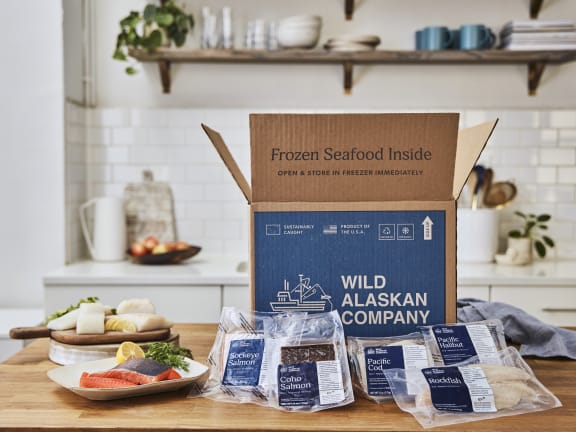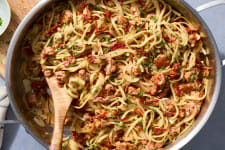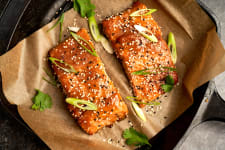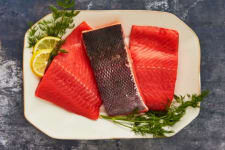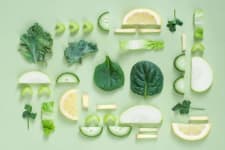The USDA estimates that approximately 30 to 40 percent of the food produced in the U.S. is wasted. That means food that otherwise could have fed people ends up in landfills — and the resources and labor that are used to grow, process, and transport that food are wasted, too.
Some of this food waste occurs in production or along the way to you, even before it reaches your kitchen table. Resourceful practices in production can ensure that waste is converted into useful products, while an efficient delivery system (what we call our cold chain) can help curb food waste by reducing the chance of spoilage or expiration. In honor of Earth Day, here are some ways a Wild Alaskan Company membership makes it easier to reduce food waste at home.
What are the environmental effects of food waste?
Each year, food waste generates the equivalent of 42 coal-fired power plants’ worth of greenhouse gas emissions, the EPA found. Food in landfills generates methane, an even more potent greenhouse gas than carbon dioxide. On top of that, food is the most common material found in landfills, comprising about a fifth of waste.
How can you reduce food waste at home?
Meal prepping
With a plan for your meals in place, you’re more likely to know what you need and what you don’t, utilizing every ingredient. Not only does meal prepping reduce waste, but it cuts down on cooking time, too, making hectic weeknights a little easier.
-
Cook fillets in advance to keep your fridge full of good eats. The night before your meal prep session, transfer fillets from the freezer to the fridge so they can defrost. Once they’re baked, poached, or steamed, pull them from the fridge throughout the week to pair with lentils, veggies, potatoes, and more.
-
Or try the opposite: meal prep your side dishes for the week, and sear fish “to order” when you’re ready to eat. For example, the beans, rice, and slaw in this fish taco-inspired dish can be prepped in advance; when it’s time to eat, pan-searing Pacific halibut takes less than 10 minutes.
Repurposing leftovers
Though it can be difficult at first to know what to do with the food scraps you might be used to discarding, a little practice and imagination can make anyone a pro at repurposing ingredients. For example:
-
Use spot prawn shells for a flavorful stock — the perfect base for curries, bisques, or stews — and enhance the flavor further with vegetable scraps.
-
Irish-style Pacific cod cakes come together with leftover Pacific cod and mashed potatoes for a whole new day-two dinner.
-
Leftover salmon is delicious flaked on top of almost anything, taking classic comfort dishes from good to great.
Don’t discard the skin
-
Not only does eating wild-caught fish skin reduce food waste, but it can also deliver immense health benefits. For example, salmon skin contains the fish’s highest concentration of omega-3 fatty acids, which can lower blood pressure and reduce your risk for heart disease.
-
If you haven’t quite perfected the nuance of seafood texture, don’t worry. Here is a foolproof method for crispy fish skin, which might soon become your favorite part of your meal.
-
If you have a pet, they might enjoy helping you to eat any cooked fish skin! Both dogs and cats may benefit from the omega-3s packed into the salmon skin, which has anti-inflammatory effects for them too — and perhaps more importantly, is a delicious treat.
Embracing resourcefulness
Just like any other natural, wild source of food, all fish do not come in the same shapes and sizes, and can’t always be cut perfectly into 6-ounce fillets. Rather than discarding the odd-sized cuts, we enjoy them as Captain Cuts and Ground Sockeye Salmon. They’re both made using the same fish we use in our regular portions, just in more creative forms. When you embrace the adventure of eating wild, you’re not only reducing consumer waste of delicious, wild-caught fish — you’re also embarking on a new culinary adventure.
Enjoy Captain Cuts and Ground Sockeye Salmon
-
The unsung glory of the tail piece, Captain Cuts are packed with all the quality, flavor, and nutrition that you’d expect from any of our salmon offerings — just cut into a different, even easier to cook shape. These quick-to-thaw, quick-to-cook cuts are ideal for snackable seafood, impromptu meals, and feeding a crowd.
-
With an especially high vitamin D content and rich flavor profile, Ground Sockeye Salmon is the perfect swap for red meat in your go-to recipes.
Embrace frozen seafood
-
Frozen seafood can be thawed whenever you want, and can be used within a day or two of thawing. However, “fresh” seafood bought at the grocery store has likely already been thawed, and might not keep past the day you buy it. Frozen seafood gives you more control with your meals and more leeway when cooking, which can reduce food waste.
Curated Boxes help us offer you what’s abundant and available
-
At Wild Alaskan Company, we’ve made a conscious choice to participate in a supply-driven food system where fewer resources go to waste.
-
Eating across multiple species — as opposed to only consuming better-known, low-availability fish — ensures our food system stays sustainable. Alaskan seafood is a responsible choice because the state’s fishing industry is the gold standard of sustainability.
-
By introducing a variety of offerings to our members, curated boxes are innately connected to resourcefulness. In putting a diversity of harvests to use, we’re able to adapt, as humans have always done, to what’s available.
Wild Alaskan Company delivers wild-caught, sustainable seafood directly to your door. Get Started.
